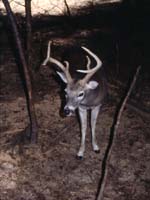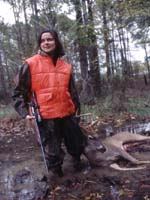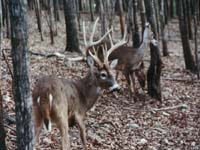
|
Features
|
|
|
|
Books
|
|
|
|
Fun & Games
|
|
|
|
Contact Us
|
|
|
John's Journal... Entry 65, Day 4
Water, Food and Bedding Trails
 EDITOR'S
NOTE: Simply finding a deer trail won't provide enough information
to make you hang a tree stand and plan to hunt that trail. Many ingredients
make some deer trails better than others. To effectively hunt trails,
you need to know ..
EDITOR'S
NOTE: Simply finding a deer trail won't provide enough information
to make you hang a tree stand and plan to hunt that trail. Many ingredients
make some deer trails better than others. To effectively hunt trails,
you need to know ..
* why and when the deer use the trail,
* where the deer will go and
* what time of day or night the deer will move down the trail.
With this information, you can hunt trails and take deer more productively than a hunter who simply finds a trail and hangs a tree stand. Let's take a closer look at some different types of deer trails and what you can learn from these trails to help you hunt more effectively.
The swamp had flooded, and acorns floated on the surface of the knee-deep water. From the numbers of cracked acorns on the bank, the deer hunters in the area knew deer had fed at this site, although they couldn't locate any tracks. One of the hunters decided to sit on the edge of the slough all day to learn the movement patterns of the deer.
In the early morning light, the hunter could hear acorns popping and water pouring as he made out a dark figure in the 2-foot-deep water. Using his binoculars, he focused on a fat doe knee-deep in the flooded timber, picking up acorns in her mouth, letting the water run out of her mouth, cracking the acorns and eating the meat of the nuts. In 2 l/2-hours, he watched l5-other does moving along the edges or in the shallow water eating acorns. These deer walked along an underwater path that led through the flooded timber and their food.
 Another
time on yet another flood plain, just at dark, a hunter located deer tracks
going into the water just at dark. The next morning he set up a tree stand
20 yards from where he'd seen the tracks going into the backwoods beaver
pond. As he watched, deer moved back and forth across the pond -- apparently
on an underwater ridge only 4 or 5 inches below the surface but not visible
from the shore. Hunting this underwater ridge produced two fine bucks
for this deer hunter during that season.
Another
time on yet another flood plain, just at dark, a hunter located deer tracks
going into the water just at dark. The next morning he set up a tree stand
20 yards from where he'd seen the tracks going into the backwoods beaver
pond. As he watched, deer moved back and forth across the pond -- apparently
on an underwater ridge only 4 or 5 inches below the surface but not visible
from the shore. Hunting this underwater ridge produced two fine bucks
for this deer hunter during that season.
Hunters consider food trails the easiest and most obvious places to attempt to take deer. However, you must set up on a food trail in the correct place to have success. You can follow a food trail easily that leads to an agricultural field, because generally the deer will enter the field at a corner, a point or some other obvious passageway. Take a stand 20 or 30 yards inside the woodline along the trail that goes to the field. But the more often someone hunts the trail, the more sensitive the deer will become to hunting pressure and probably will stay well down the trail before dark.
Generally an experienced hunter will set up well away from a food plot to intercept a deer earlier, since many deer won't enter a food plot until almost dark to be safe. Too, at that time of the day, often the light's too bad to shoot accurately.
Often the bigger, better-sized bucks will wait just before dark l00 to 200 yards down the trails that lead to the greenfield. If you can find an alternative food source like an acorn tree or some wild vegetation where deer feed along that trail leading to the greenfield, you've located a productive spot to bag a buck.
Look for the most productive food trees in isolated regions. If several trails from various directions lead into that food tree, you may not know where to place your tree stand. However, you can funnel deer from one trail to another by using human odor as a barrier on the trails you don't want the deer to travel down.
Ronnie Groom, owner of C & G Sporting Goods in Panama City, Florida, and a deer-hunting instructor at numerous hunting schools across the South, suggests that you, "Move l50 to 200 yards away from the food tree. Then walk across each of the trails you don't want the deer to use -- carefully leaving plenty of human odor on these trails. When the deer come down the trail you've tried to X out, they'll smell human odor, leave the trail they're on, and move to the trail you want them to walk down that doesn't have human odor it."
 Hunting
the buck as he goes to his bed presents another hunting opportunity. In
most areas when deer have intense hunting pressure, they will move to
their beds just at daylight. By locating a buck's food source and where
he beds, you can place your stand and climb in it before daylight. One
bowhunter says he gets as close to a bedding area as he can without disturbing
the deer to have the most light. He mentions that he hunts farther off
the trails than most people and always on the downwind side. This avid
hunter doesn't hunt too close to where he anticipates taking a shot. When
scouting a bedding region, spend as little time as possible to determine
where to put your tree stand. Deer won't feel secure in a bedding area
if they detect human odor. Always scout bedding sites in advance of deer
season before the bucks become so sensitive to human sightings and smell.
Don't cross any bedding trails if you can avoid them, and even go out
of your way to not cross them.
Hunting
the buck as he goes to his bed presents another hunting opportunity. In
most areas when deer have intense hunting pressure, they will move to
their beds just at daylight. By locating a buck's food source and where
he beds, you can place your stand and climb in it before daylight. One
bowhunter says he gets as close to a bedding area as he can without disturbing
the deer to have the most light. He mentions that he hunts farther off
the trails than most people and always on the downwind side. This avid
hunter doesn't hunt too close to where he anticipates taking a shot. When
scouting a bedding region, spend as little time as possible to determine
where to put your tree stand. Deer won't feel secure in a bedding area
if they detect human odor. Always scout bedding sites in advance of deer
season before the bucks become so sensitive to human sightings and smell.
Don't cross any bedding trails if you can avoid them, and even go out
of your way to not cross them.
Also, never hunt a deer's bedding area when the wind's blowing in the wrong direction. If you're hunting next to lowlands, remember air usually will move from higher elevations to the lower part of a hollow in the evenings. Set up on the lower side of the trail going to and from where the deer's bedding. If you plan to hunt a bedding trail in the morning, don't forget that because air rises at that time, you should place your tree stand on the upper side of the trail.
If you can't get to a bedding site well before daylight and be on your stand that's set up with a favorable wind direction, then hunt another place that day. If you spook a buck coming to his bed, more than likely that's the last time you'll see that animal during the season.
Tomorrow: Escape Trails and Night Trails
Check back each day this week for more about Reading Whitetails' Travel Routes ...
Day 1 -Types of Whitetail
Highways
Day 2 -Trash Trails and Meandering Trails
Day 3 -Terrain Trails and Mating Trails
Day 4 -Water, Food and Bedding Trails
Day 5 -Escape Trails and Night Trails